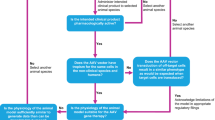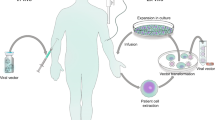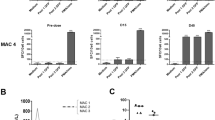Abstract
Gene therapy is usually reserved for severe and medically refractory disorders because of the toxicity, potential long-term risks and invasiveness of most gene transfer protocols. Here we show that an orally administered adeno-associated viral vector leads to persistent expression of a ß-galactosidase transgene in both gut epithelial and lamina propria cells, and that this approach results in long-term phenotypic recovery in an animal model of lactose intolerance. A gene 'pill' associated with highly efficient and stable gene expression might be a practical and cost-effective strategy for even relatively mild disorders, such as lactase deficiency.
This is a preview of subscription content, access via your institution
Access options
Subscribe to this journal
Receive 12 print issues and online access
$259.00 per year
only $21.58 per issue
Buy this article
- Purchase on SpringerLink
- Instant access to full article PDF
Prices may be subject to local taxes which are calculated during checkout






Similar content being viewed by others
References
Sahi, T., Isokoski, M., Jussila, J., Launiala, K. & Piorala, K. Recessive inheritance of adult-type lactose malabsorption. Lancet 2, 823– 826 (1973).
Lisker, R., Gonzalez, B. & Daltabuit, M. Recessive inheritance of the adult type of intestinal lactase deficiency. Am. J. Hum. Genet. 27, 662–664 (1975).
Flatz, G. Genetics of lactose digestion in humans. Adv. Human Genet. 16, 1–77 (1987).
Sandler, R.B. et al. Postmenopausal bone density and milk consumption in childhood and adolescence. Am. J. Clin. Nutr. 42, 270–274 (1985).
Birge, S.J., Keutmann, H.T., Cuatrecasas, P. & Whedon, G.D. Osteoporosis, intestinal deficiency and low dietarty calcium intake. New Engl. J. Med. 276, 445–448 (1967).
Honkanen, R. et al. Lactose intolerance associated with fractures of weight-bearing bones in Finnish women aged 38–57 years. Bone 21, 473–477 (1997).
Stallings, V.A., Oddleifson, N.W, Negrini, B.Y., Zemel, B.S. & Wellens, R. Bone mineral content and dietary calcium intake in children prescribed a low-lactose diet. J. Ped. Gastroenterol. Nutr. 18, 440–5 (1994).
Buller, H.A. et al. New insights into the lactase and glycosylceramindase adctivities of rat microvillus membrane lactase-phlorizin hydrolase. Am. J. Physiol. 257, G616–G623 (1989).
Scrimshaw, N.S. & Murray, E.B. The acceptability of milk and milk products in populations with a high prevalence of lactose intolerance . Am. J. Clin. Nutr. 48, 1083 –1159 (1988).
Montgomery, R.K., Buller, H.A., Rings, E.H. & Grand, R.J. Lactose intolerance and the genetic regulation of intestinal lactase-phlorizin hydrolase. FASEB J. 5, 2824– 32 (1991).
Witte, J., Lloyd, M., Lorenzsonn, V., Korsmo, H. & Olsen, W. The biosynthetic basis of adult lactase deficiency. J. Clin. Invest. 86, 1338– 42 (1990).
Maiuri, L. et al. Mosaic regulation of lactase in human adult-type hypolactasia. Gastroenterology 107, 54– 60 (1994).
Sebastio, G. et al. The control of lactase in human adult-type hypolactasia and in weaning rabbits and rats. Am. J. Human Genet. 45 , 489–497 (1989).
Sterchi, E.E. et al. Biogenesis of intestinal lactase-phlorizin hydrolase in adults with lactose intolerance. Evidence for reduced biosynthesis and slowed-down maturation in enterocytes. J. Clin. Invest. 86, 1329–37 (1990).
Berns, K.I. & Hauswirth, W.W. Adeno-associated viruses. Adv. Virus Res. 25, 407–409 (1979).
Samulski, R.J., Chang. L-S. & Shenk, T. Helper-free stocks of adeno-associated viruses: normal integration does not require viral gene expression. J. Virol. 63, 3822–3828 ( 1989).
Xiao, X., Li, J. & Samulski, R.J. Efficient long-term gene transfer into muscle tissue of immuno-competent mice by adeno-associated virus vector. J. Virol. 70, 8098–108 ( 1996).
Kaplitt, M.G et al. Long-term gene expression and phenotypic correction using adeno-associated virus vectors in the mammalian brain. Nature Genet. 8, 148–154 ( 1994).
Trier, J.S. Structure and function of intestinal M cells. Gastroenterol. Clin. North Am. 20, 531–547 ( 1991).
Service, R.F. Triggering the first line of defense. Science 265, 1522–1524 (1994).
Darji A. et al. Oral somatic transgene vaccination using attenuated S. typhimurium. Cell. 91, 765–75 (1997).
During, M.J. et al. Glucose modulates rat substantia nigra GABA release in the freely-moving rat via an effect on ATP-sensitive potassium channels. J. Clin. Invest. 95, 2403–2408 (1995).
Kaplitt, M.G. et al. Preproenkephalin promoter yields region-specific and long-term expression in adult brain following direct in vivo gene transfer via a defective herpes simplex viral vector. Proc. Natl. Acad. Sci. USA 91, 8979–8983 (1994).
Acknowledgements
This work was supported by grants from the Juvenile Diabetes Foundation International, the New Zealand Health Research Council, New Zealand Marsden Fund and the New Zealand Lotteries Board.
Author information
Authors and Affiliations
Corresponding author
Rights and permissions
About this article
Cite this article
During, M., Xu, R., Young, D. et al. Peroral gene therapy of lactose intolerance using an adeno-associated virus vector. Nat Med 4, 1131–1135 (1998). https://doi.org/10.1038/2625
Received:
Accepted:
Issue date:
DOI: https://doi.org/10.1038/2625
This article is cited by
-
Targeting the gastrointestinal tract with viral vectors: state of the art and possible applications in research and therapy
Histochemistry and Cell Biology (2016)
-
Targeted Gene Delivery to the Enteric Nervous System Using AAV: A Comparison Across Serotypes and Capsid Mutants
Molecular Therapy (2015)
-
Modular adeno-associated virus (rAAV) vectors used for cellular virus-directed enzyme prodrug therapy
Scientific Reports (2014)
-
Oral Administration of Recombinant Adeno-associated Virus-mediated Bone Morphogenetic Protein-7 Suppresses CCl4-induced Hepatic Fibrosis in Mice
Molecular Therapy (2012)
-
New pathophysiological insights and modern treatment of IBD
Journal of Gastroenterology (2010)



